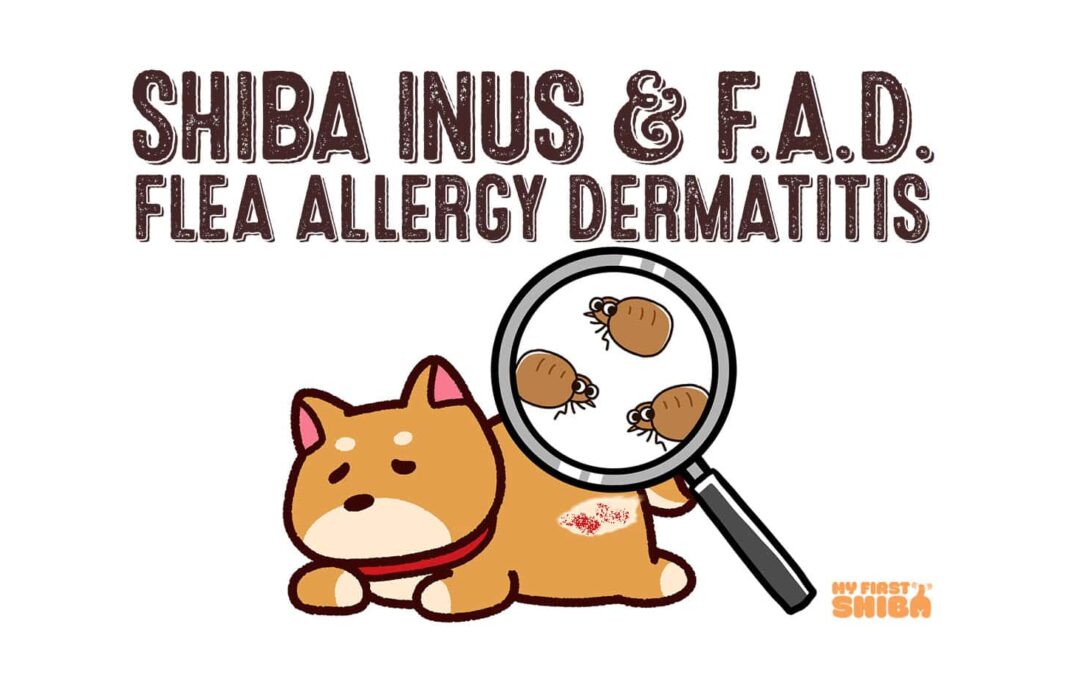On occasion, our posts contain affiliate links. However, we only recommend products that we truly believe in. For more information, visit my privacy policy page.

Author: Carla Germano, DVM
Fleas are a very common problem and can make any dog itchy and scratchy!
In most cases, dogs with fleas can be easily treated.
However, in some cases, flea bites, those predisposed to allergies, or severe infestation can cause a dog to have an allergic reaction that leads to rashes, scabs and skin infections.
This is called Flea Allergy Dermatitis or FAD for short.
These cases can be a little bit more difficult to manage and require additional treatments and medications.
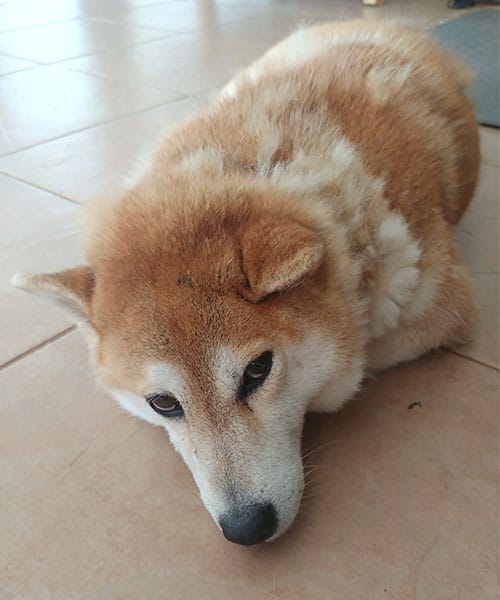
How To Tell If Your Shiba Inu Has Fleas
If you notice your Shiba is scratching more than usual, it’s a great idea to check for fleas.
A flea comb, which can be purchased for a few dollars at your local pet store, is a great way to find live fleas as they can sometimes be very quick and hard to track down.
Another telling sign of fleas is “flea dirt”, which appears as tiny black dots on the skin between the hairs.
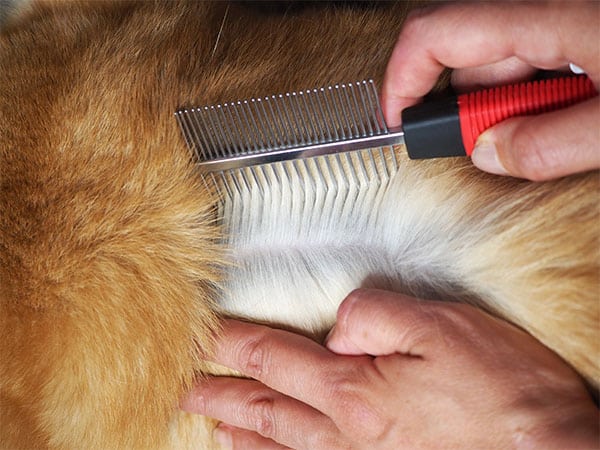
This is actually the fecal matter of the flea that it leaves behind after biting a dog and getting a small meal of its blood! Ick!
Since it is mostly made of blood, if you aren’t sure, you can put some of the dirt on a white napkin and wet it with alcohol or smush it and it will likely leave a reddish stain.
Fleas tend to congregate around the neck and around the tail/hind legs so this is a good place to comb and look for flea dirt.
Since Shiba Inus have a dense undercoat, it's important to part the fur all the way down to the skin to see any evidence!
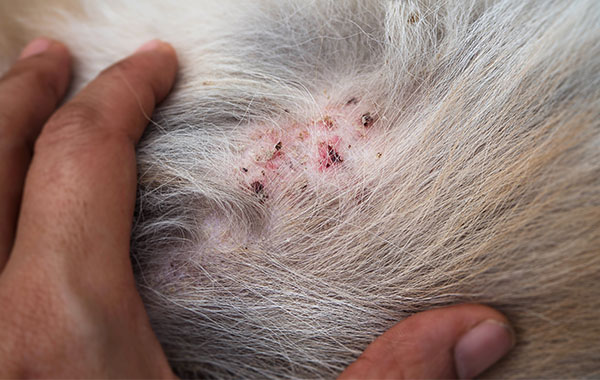
How Would I Know If My Shiba Inu Has F.A.D.?
Flea dermatitis is usually more severe than just some itching.
In most dogs with FAD you will also see scabs, redness, open wounds and/or extreme levels of itching.
Flea bites also tend to cause lots of tiny red bumps on the skin called “miliary dermatitis”.
Since Shiba Inus do tend to get allergies, it is also possible they are slightly predisposed to this condition however it can occur in any breed.
It's important to note, some dogs only need one single flea bite to cause this type of skin reaction, so even if your dog is on a flea preventative or you do not find evidence of flea infestation, the symptoms can still be caused by fleas.
Luckily, most dermatitis cases are treated similarly so even if we never find that one interloper, it can still be managed.
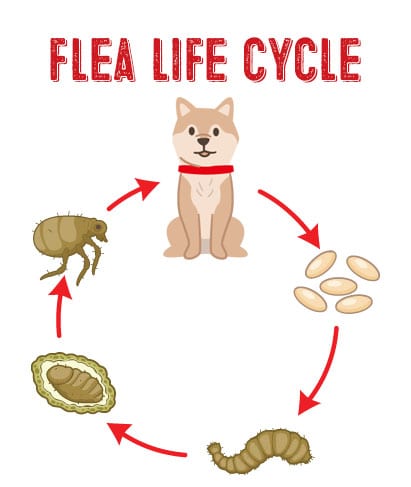
How Long Does F.A.D. Last?
Flea dermatitis will likely continue until all of the fleas are gone from the environment and any secondary inflammation and infection are controlled.
This can take a very variable amount of time depending on the dog's immune system and level of fleas.
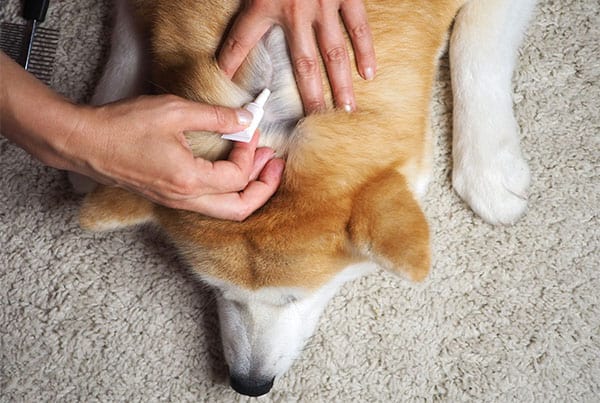
Best Way To Treat Fleas
The first important step is to rid their environment and your Shiba of fleas.
Unfortunately, there are no preventatives or medicines that can completely prevent fleas from biting altogether so some dogs will continue to be itchy and live fleas may be seen for up to 3 months until the infestation is under control.
This is due to the flea life cycle.
Once a flea lands on your dog it will bite - fleas need the dogs' blood to reproduce so now they can start laying eggs which then fall off your dog into the environment.
Live fleas can jump around but need to spend the majority of their time on a living dog or cat (they cannot reproduce after biting a human), but the eggs can take up to 3 months to hatch once they are laid.
Once the eggs hatch the fleas can jump back on your dog so you may see a live flea here or there over the next few months.
This is why it is important to start an effective flea preventative right away and give it consistently every month to every pet in the household.
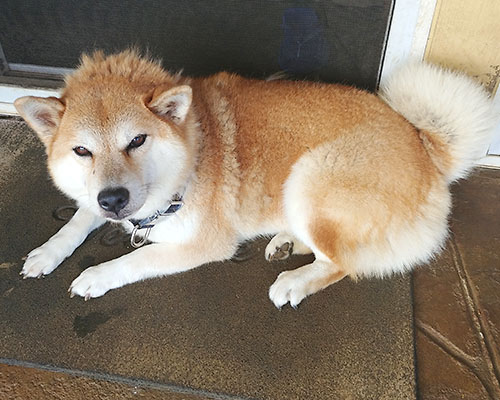
The preventative will stop the fleas from replicating if they jump back on or try to jump on any other pets and eventually all the fleas will be gone.
If your dog has a large number of live fleas or any symptoms of flea allergy dermatitis it's recommended to bring them to the veterinarian as additional treatments may be needed.
One oral medicine that works great is called nitenpyram, brand name Capstar. This medication is usually given as a single dose and will kill all the live fleas on your dog for 24 hours.
This helps dramatically reduce the itching/crawling sensation most dogs feel and reduces the fall off of any more eggs from the existing live fleas.
You can wash any bedding or blankets your dog has been near in a hot washer and dryer.
You can also sprinkle Borax on any carpets and then vacuum it up. This helps dry out the flea eggs so they are less likely to hatch.
Remember: do not throw away the contents of your vacuum inside the house, put it directly in an outside trash bin as the fleas can hatch in the debris.
In very severe cases, an exterminator may need to be called.
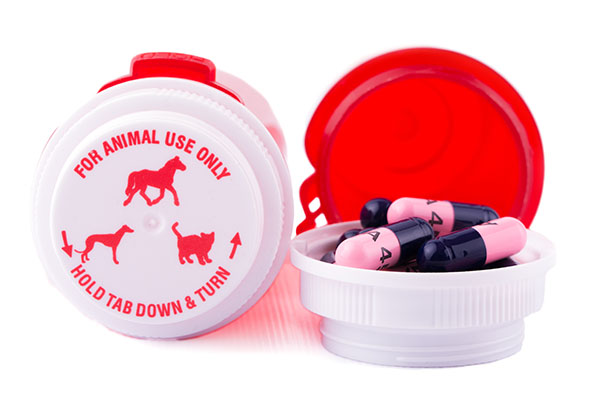
How Is F.A.D. Treated?
Once the fleas are on their way to being eradicated, the next step is to manage any discomfort or skin lesions that have developed as a result of flea dermatitis.
Since FAD triggers a significant immune response, just getting rid of the fleas is not always enough.
Treating skin disease often involves a multi-modal approach and can differ based on an individual dog’s symptoms.
One of the most important plan of action is to control the itching.
If a dog is still itchy it will scratch and lick itself which can worsen an existing dermatitis and add mouth bacteria into the mix.
I know some medications can be scary any any medication can have unforeseeable side effects, but itching is also extremely uncomfortable for your dog and maintaining comfort and quality of life are the most important aspect of our job as veterinarians.
Most veterinarians do not take unnecessary risks and always try to prescribe the least amount we think is necessary to achieve our goal. We would never knowingly put your pet at risk.
In cases of severe inflammation and itching, oral steroids are usually the medication of choice.
While they may have some annoying but temporary side effects such as increased drinking and urination, in short courses these medications are quite safe and are the most effective anti-inflammatory medication that exists.
If there is no significant inflammation and your dog is only moderately itchy, we have medications like Apoquel and an injection called Cytopoint that can help with mild to moderate itching.
These are both extremely safe and can be used short term very effectively.
They have been rigorously tested and have high margins of safety.
I use these medications frequently and almost never see negative side effects from them, especially in the short term.
Over the counter antihistamines like diphenhydramine, cetirizine and loratadine can help some with mild itching but not all dogs respond to them.
You can call your veterinarian to get an appropriate dose for your pet.
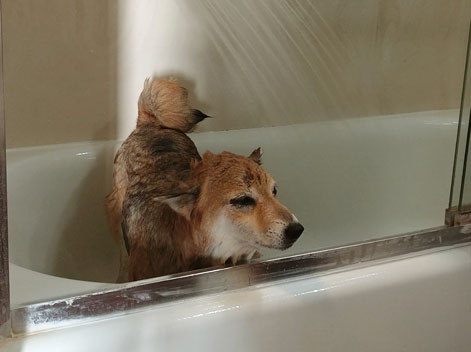
There are also some medicated shampoos, sprays and mousses that contain low doses of topical steroids that can help with mild itching.
It's important to check with your veterinarian before using any of these since they can be contraindicated in certain situations.
Ointments are not generally used for all over treatment but if there is one large wound that can be treated directly, they can be useful.
Most of these would be prescribed by your veterinarian but human triple antibiotic ointment can be used judiciously on sores if you cannot get to the veterinarian right away.
Your veterinarian will check the skin for signs of infection and decide if topical, oral or injectable antibiotics are needed.
Flea-specific shampoos or flea baths that can be bought over the counter are not really recommended except as a last resort but they can be risky.
Some animals do not react well to these products, they only provide temporary relief, and they are not well regulated so they can contain toxins or irritants.
How To Prevent F.A.D. From Affecting Your Shiba
As previously mentioned, preventing fleas is one of the most important ways to prevent FAD.
All dogs (and cats) should be on a flea preventative year-round, even in the colder months.
Many people commonly believe that fleas are not an issue in the winter, but this is incorrect.
They may be less active, but I still see many cases of fleas even in the coldest months of the year.
Additionally, fleas tend to have a way of hitchhiking into homes on mice, visiting pets, and on clothes for short distances. As a result, any dog is at risk for becoming a home to these annoying creatures.
Flea preventatives come in all types but they are not created equally.
Most of them are oral or topical and many require a prescription from your veterinarian.
With the exception of Advantage/Advantix and Frontline products, most of the other brands you can purchase over the counter are considered dangerous.
Many of these products are not monitored and contain toxic ingredients that can cause severe symptoms including seizures and other neurological symptoms.
Veterinarians usually recommend sticking to a brand name product as these are more throughly vetted and many of them carry some amount of guarantee depending on where you live.
This means the company MAY even help pay for your dog’s treatment if you have been using them appropriately.
Depending on your individual pet’s needs and lifestyle, your veterinarian can help you decide what is the best option for your dog.
Unfortunately, none of the home remedies like garlic, diatomaceous earth, etc. that you can find on the internet have been proven to actually prevent fleas effectively.
Monthly preventative medications are extremely important to your dog’s health and the brand name products are tested and have high margins of safety.
They also help prevent several other diseases such as intestinal parasites and tick-born illnesses.
In conclusion, fleas can be troublesome and inconvenient but with proper prevention they can be managed or even avoided.
Flea allergy dermatitis is, in most cases, not a severe diagnosis but serious infections or long-term allergy problems can, sometimes, result.
If your first efforts are not successful or you are noticing anything else abnormal about your Shiba’s skin, please seek out veterinary care as they can be very helpful in these situations.
Finding an Ethical Shiba Inu Breeder in California

Thanks for visiting Myfirstshiba.com! We do our very best in providing our readers with awesome content about our beloved Shiba Inu breed. Some of our articles include reviews and recommendations to our favorite products. We do occasionally earn commissions from certain affiliate links that help support our work and mission. Thanks again for visiting. Shiba Kisses To All!

